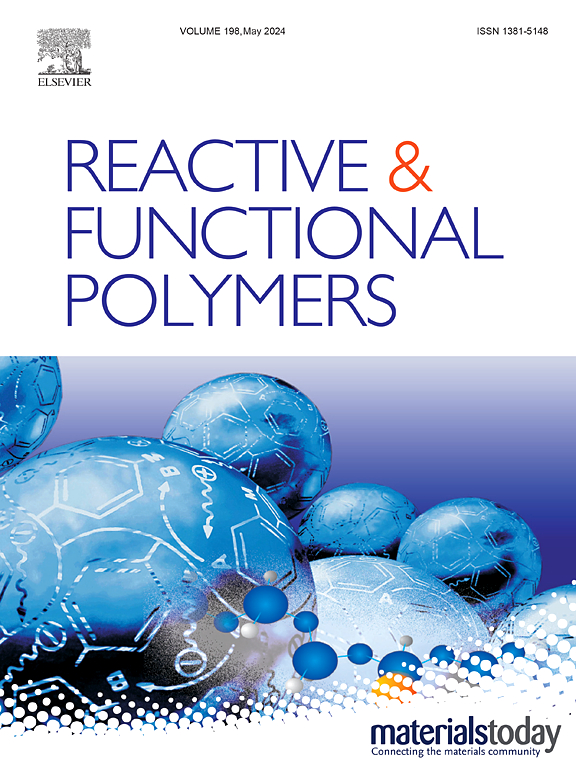Modified polystyrene waste in the adsorptive removal of crystal violet and Cu (II) ion from aqueous medium – Groundwater applicability, modelling and characterization studies
IF 5.1
3区 工程技术
Q1 CHEMISTRY, APPLIED
引用次数: 0
Abstract
The waste polystyrene in the sulfonated form was utilized as an adsorbent material for the exclusion of a crystal violet and copper (II) ion from synthetic solution and groundwater. The adsorptive removal of CV and Cu (II) ion as a function of time, pH, SPS dose, initial concentration and temperature was studied. The maximum uptake of CV and Cu (II) of 812 ± 6 mg/g (pH 3–10.5) and 257.3 mg/g (pH 6.03) was observed respectively at an equilibrium time of 60 min. An exothermic nature of sorption (− ΔH°) decreased the removal efficiency by 11 % and 16.5 ± 3.5 % for CV and Cu (II) respectively. The spontaneity of adsorption was reflected from the negative ΔG° values with decreasing randomness (− ΔS°) upon increasing the temperature. The adsorption kinetics (pseudo – first – order, pseudo – second – order, intra – particle diffusion and Elovich) and isotherms models (Langmuir, Freundlich and DKR) in compliance with the present (CV and Cu2+) adsorption systems were checked. The stability and efficiency for successive regeneration cycles (uptake of CV ≥ 78 % up to six cycles) inferred that SPS was superior for CV than that of Cu (II) ion. Conspicuously, the removal of 98 % of CV from groundwater was achieved, nonetheless, the Cu (II) ion removal was 56 % due to competing Ca2+ and Mg2+ ions in groundwater. The signature of copper oxides on the SPS was corroborated from the XRD patterns along with the expansion and contraction of SPS crystallites during the adsorption and regeneration processes respectively. The SEM and FTIR studies described the morphological and vibrational modifications of virgin and CV/Cu (II) laden SPS adsorbent. The twin application of SPS in CV and Cu (II) removal has been detailed with a plausible mechanism in this paper.

改性聚苯乙烯废物在水介质中吸附去除结晶紫和Cu (II)离子——地下水的适用性、建模和表征研究
利用磺化后的废聚苯乙烯作为吸附材料,从合成溶液和地下水中去除结晶紫和铜离子。研究了吸附去除CV和Cu (II)离子与时间、pH、SPS剂量、初始浓度和温度的关系。在平衡时间为60 min时,CV和Cu (II)的最大吸收率分别为812±6 mg/g (pH 3-10.5)和257.3 mg/g (pH 6.03)。放热吸附(−ΔH°)使CV和Cu (II)的去除率分别降低11%和16.5±3.5%。随着温度的升高,吸附的自发性随负ΔG°值的增大而减小(- ΔS°)。验证了吸附动力学(拟一级、拟二级、颗粒内扩散和Elovich)和等温线模型(Langmuir、Freundlich和DKR)是否符合现有(CV和Cu2+)吸附体系。连续再生循环的稳定性和效率(6次循环中CV的吸收率≥78%)表明SPS对CV的处理优于Cu (II)离子。值得注意的是,地下水中CV的去除率达到98%,但由于地下水中Ca2+和Mg2+离子的竞争,Cu (II)离子的去除率为56%。吸附和再生过程中SPS晶体的膨胀和收缩分别证实了SPS上铜氧化物的特征。SEM和FTIR研究描述了原生和CV/Cu (II)负载SPS吸附剂的形态和振动变化。本文详细介绍了SPS在CV和Cu (II)脱除中的双重应用,并给出了可行的机理。
本文章由计算机程序翻译,如有差异,请以英文原文为准。
求助全文
约1分钟内获得全文
求助全文
来源期刊

Reactive & Functional Polymers
工程技术-高分子科学
CiteScore
8.90
自引率
5.90%
发文量
259
审稿时长
27 days
期刊介绍:
Reactive & Functional Polymers provides a forum to disseminate original ideas, concepts and developments in the science and technology of polymers with functional groups, which impart specific chemical reactivity or physical, chemical, structural, biological, and pharmacological functionality. The scope covers organic polymers, acting for instance as reagents, catalysts, templates, ion-exchangers, selective sorbents, chelating or antimicrobial agents, drug carriers, sensors, membranes, and hydrogels. This also includes reactive cross-linkable prepolymers and high-performance thermosetting polymers, natural or degradable polymers, conducting polymers, and porous polymers.
Original research articles must contain thorough molecular and material characterization data on synthesis of the above polymers in combination with their applications. Applications include but are not limited to catalysis, water or effluent treatment, separations and recovery, electronics and information storage, energy conversion, encapsulation, or adhesion.
 求助内容:
求助内容: 应助结果提醒方式:
应助结果提醒方式:


